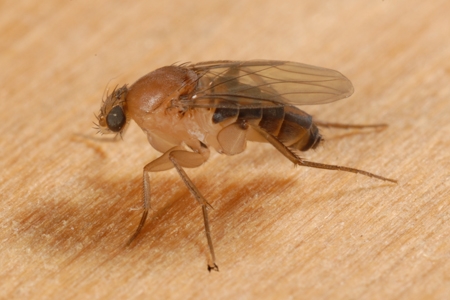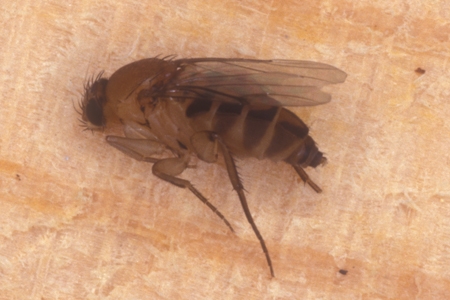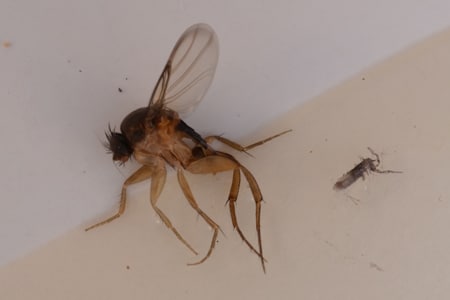Active Seasons




Phorid Fly Appearance and Size Facts
Phorid flies, also known as humpbacked flies, are tan-brown with black eyes. Their most noticeable feature is the humpbacked shape of their thorax, which has earned them their nickname. The insects are roughly 1/8 inch long and have fine hairs. Despite their small size, they are known for their quick and erratic movements, which make them difficult to catch.
Identifying Phorid Flies From Other Flies
There are a few key characteristics to look out for when identifying phorid flies from other flies. The first thing to distinguish phorid flies from other fly species is their humpbacked thorax. Additionally, phorid flies don’t have the red eye color of fruit flies, so they’re easier to identify.
Phorid flies don’t immediately fly when disturbed. Instead, they run across surfaces rapidly, making them hard to catch. Their quick movements, dark-brown or black coloration, and small size set them apart from other types of flies. For this reason, they are also called scuttle-flies.
We offer phorid fly control in the following locations and their surround areas:

Behavior and Habitat of Phorid Flies
Unlike other house-infesting flies, phorid flies can breed in a wide range of materials because they have a remarkable reproductive potential. These flies are strong fliers, capable of traveling up to six miles in 24 hours.
Due to their unsanitary habits and potential to spread disease-causing bacteria onto food products, phorid flies pose a particular threat to homes, hospitals, healthcare facilities, and restaurants. Furthermore, their ability to crawl through small spaces gives them access to hard-to-reach areas. Understanding their behavior and preferred habitat is crucial to controlling phorid fly infestations.

Signs of Infestation of Phorid Flies
You know you have an infestation when you see phorid flies buzzing and scurrying across surfaces. One standard indicator is if phorid flies hover or crawl around compost piles or garbage bins with decaying organic matter. Look for small, tan eggs or larvae in moist areas to detect phorid flies. Phorid flies can also increase fly activity indoors, particularly near drains, sinks, and food preparation areas. You can get rid of them quickly if you remain vigilant for these signs. Phorid fly can also be found infesting drainage lines, A/C drip pans, utility drip pans, kitty litter, and more.

Tips for Prevention of Phorid Flies
To prevent phorid flies, empty your trash and put it outside. Clean your trash receptacles and any food spills to keep these flies at bay. Additionally, keep drains clean and remove organic deposits to eliminate breeding sites. Address moisture issues to reduce risks further. Contact a pest control company like Hulett Environmental Services if these prevention tips don’t work.
Getting Rid of Phorid Flies
Start by identifying and eliminating their breeding sites, like decaying organic matter or moisture-rich areas. Make sure drains, trash containers, and other breeding grounds are clean. Remove phorid flies with sticky traps or adhesive tape to keep them away. Hulett Environmental Services can provide long-term relief from phorid fly infestations if these methods don’t work.
Effective Phorid Fly Control Solutions
With our experience in pest control, we can help you eliminate and prevent phorid fly infestations. Look no further than Hulett Environmental Services for effective phorid fly control solutions. Hulett offers free inspections and tailored treatments for phorid flies, whether you’re a restaurant owner or a homeowner. Call Hulett Environmental Services today to eliminate these pesky pests and enjoy a fly-free environment.



